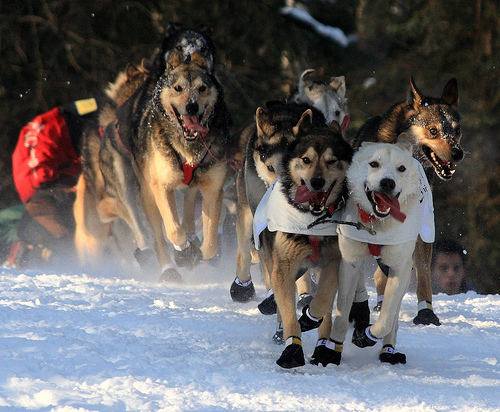Dogsledding in Alaska: 6 Things You May Not Know About Alaska’s State Sport
Back To Blog
Some rights reserved by Alaskan Dude.
- Contrary to popular belief, Alaskan huskies, not Siberian huskies, are the most used breed of sled dog in today’s northern sled dog teams. The modern Alaskan husky is a unique blend of two primary types of dogs. This crossbreed, a mix between pure northern canine breeds and other types of dogs, is the result of many generations of purposeful breeding that began in the late 1800s.
- Dog sleds were historically used by the Indigenous peoples of Alaska, but this mode of transportation became most famous during the 1925 diphtheria outbreak in Nome. At the time, the closest town with enough medication to treat Nome’s residents was 700 miles away and could only be reached by dog sled. A dog sled relay was set up by the villages between Nenana and Nome, and 20 teams worked together to relay the serum to Nome in six days.
- The Iditarod Trail Sled Dog Race stands as an iconic testament to the enduring spirit of dog sledding and Alaska’s rich history. Spanning roughly 1,000 miles this annual event commemorates the historic serum run to Nome in 1925. Today, mushers and their teams navigate the challenging landscape as a tribute to the historical significance of dog sledding in Alaska history.
- For Alaska Native people, dog sleds were integral to their way of life, serving as a primary mode of transportation across the snowy terrain. These sleds facilitated travel for hunting, trading and transportation of goods and people between communities in the harsh Arctic conditions.
- As dogs are not driven with reins but by spoken commands, the dog who leads the team must understand all that is said to them and guide the others accordingly. An intelligent dog leader is therefore an absolute necessity and truly man’s best friend in the sport.
- Dogs used for freight and long-distance should have dense, warm coats to hold heat in, and dogs used for sprints should have short coats that let heat out. Most sled dogs have a double coat, with the outer coat keeping snow away from the body, and a waterproof inner coat for insulation.
There are endless opportunities to experience the thrill of dog mushing, and they are not limited to any season. In summer, visitors can dog sled through well-traveled trails on wheels or take a helicopter ride to a glacier for the once-in-a-lifetime experience of mushing their own sled and dog team. In early March, visitors can watch the ceremonial start of the Iditarod Trail Sled Dog Race in downtown Anchorage, or can venture to Willow for the official race start.
Many kennel owners offer rides, tours, demonstrations and a chance to snuggle with precious sled dog puppies. Others create custom overnight and multi-day tours that allow visitors to become the driver and experience firsthand what it’s like to be an Iditarod Trail Sled Dog Race musher.
Enjoy the ride!